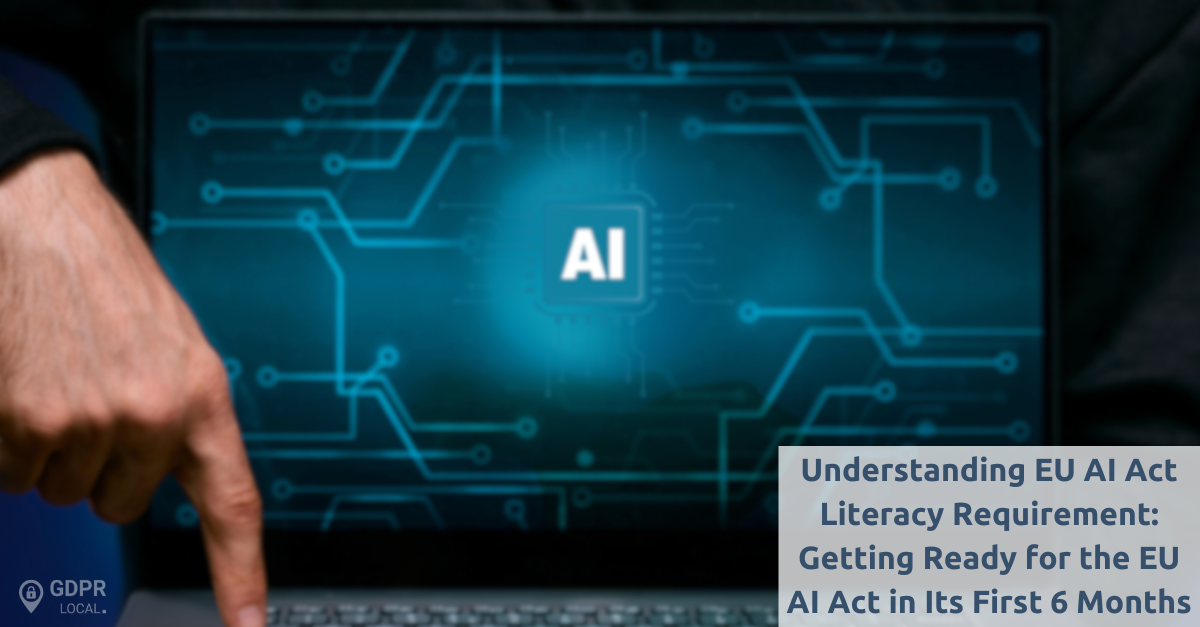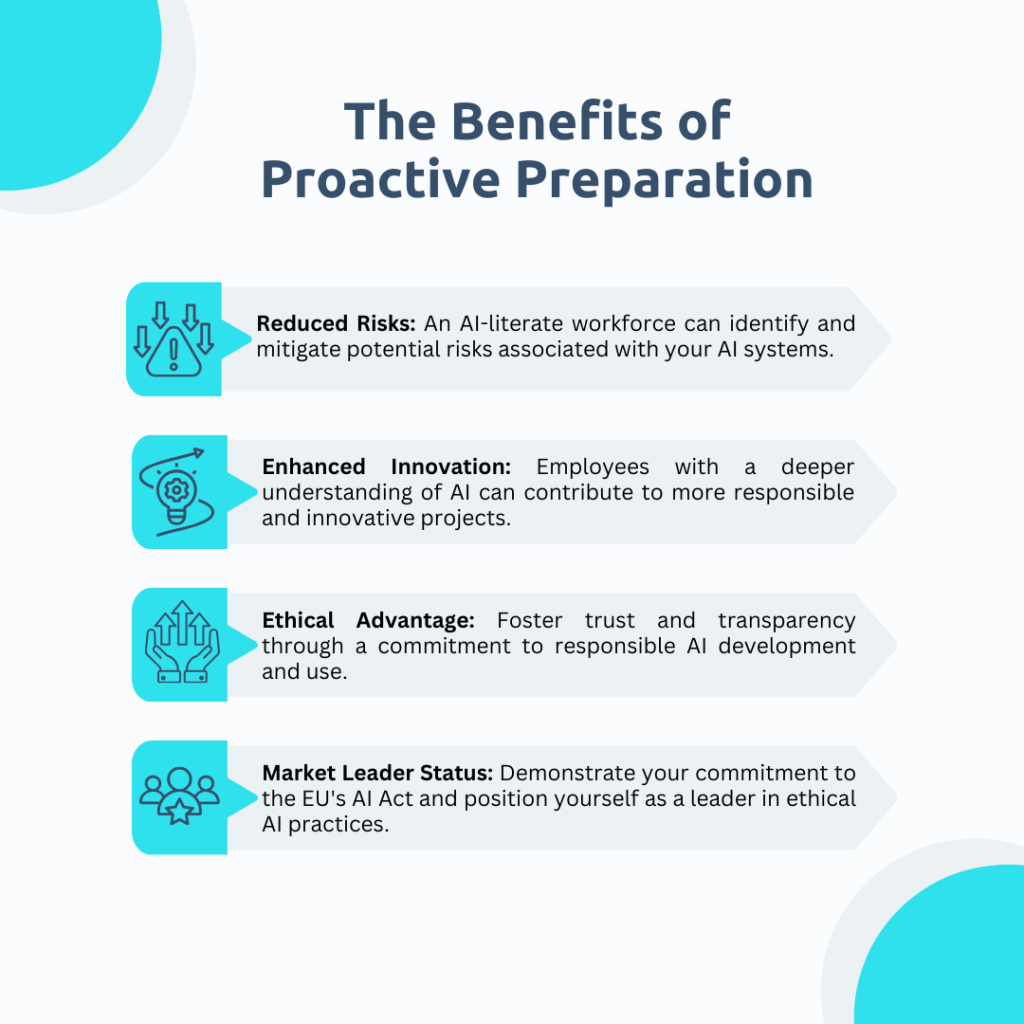
Understanding EU AI Act Literacy Requirement: Getting Ready for the EU AI Act in Its First 6 Months
The AI Act, a pioneering regulation aimed at governing the use of AI within the European Union, will be fully applicable by 2 August 2026. However, specific provisions will come into force earlier, with significant implications for AI literacy and the operation of generative and high-risk AI models.
Key Dates and Provisions
According to the European Commission’s explanation, the Act will be implemented in a staged manner, with specific provisions coming into effect at different times.
This phased approach will ensure:
– Smooth transition: Businesses and organisations have time to adapt their AI practices to comply with the new regulations.
– Focus on priorities: Initial focus is on AI literacy and governance frameworks to lay the groundwork for responsible AI development.
– Gradual implementation: As the Act comes into full force, higher risk aspects of AI are addressed progressively.
Key Dates and Provisions for AI Act implementation are:
| 2 February 2025 | Prohibitions, definitions, and provisions related to AI literacy will apply. |
| 2 August 2025 | Rules on governance and obligations for general-purpose AI become applicable. |
| 2 August 2026 | Obligations for high-risk AI systems will apply. |
AI literacy refers to the understanding and knowledge required to effectively use and manage AI technologies. This includes having a knowledge of how AI systems work, their potential impacts, and the ethical considerations involved. As AI becomes more integrated into various sectors, enhancing AI literacy is essential for both individuals and organizations to navigate the complexities of AI responsibly.
Why is AI Literacy Important?
Imagine this: Your company develops a cutting-edge AI model for content creation. It’s powerful, efficient, and generates fantastic results. But what if your employees, from developers to marketing teams, don’t understand the potential biases inherent in AI systems?
To recognise these potential biases, it’s essential for them to understand the fundamentals of AI literacy. AI literacy empowers your workforce to:
– Understand AI technologies and their potential impacts.
– Identify and mitigate risks associated with AI systems.
– Develop ethical AI practices.
– Comply with regulatory requirements.
Preparing for AI Literacy Provisions
By 2 February 2025, each organization that develops or deploys an AI system/model must ensure that it is aligned with the AI literacy provisions of the AI Act. This involves:
| Training and Education | Implementing comprehensive training programs to educate employees about AI technologies, their applications, and ethical implications. |
| Awareness Campaigns | Conducting awareness campaigns to inform stakeholders about the importance of AI literacy and the upcoming regulatory requirements. |
| Resource Development | Creating and distributing resources such as guides, tutorials, and workshops to enhance AI literacy within the organization. |
The Benefits of Proactive Preparation
By prioritising AI literacy, you’re not just complying with regulations; you’re investing in a future-proof workforce. Your company will reap the benefits of:

Preparing for Generative AI Models
Generative AI models, which create new content based on existing data, will be subject to governance rules starting 2 August 2025.
Operators of these models should prioritise risk assessment and establish strong governance frameworks. Key steps include:
Risk Assessment Procedures
– Identify Risks: Map out potential risks, such as technical failures, biases, operational misuse, data breaches, and societal impacts like ethical concerns.
– Evaluate Impact and Likelihood: Assess the impact and likelihood of each risk to prioritize them effectively.
– Mitigation Strategies: Develop strategies to address these risks, including technical improvements, security measures, and organisational actions like staff training.
– Continuous Monitoring: Set up continuous monitoring to detect and respond to emerging risks, supported by regular audits.
Governance Framework
– Establish Policies and Roles: Define clear policies and assign roles to ensure structured oversight and accountability.
– Ethical Guidelines: Create and enforce guidelines that address fairness, transparency, and accountability in AI development and deployment.
– Compliance Checks: Conduct regular checks to ensure AI systems adhere to internal policies and external regulations.
Documentation and Reporting
– Maintain Detailed Records: Keep comprehensive documentation of AI activities, including development processes, risk assessments, and mitigation efforts.
– Transparent Reporting: Implement transparent reporting mechanisms to communicate AI system performance, risks, and regulatory adherence to stakeholders.
Collaboration and Training
– Engage with Regulators: Stay in close contact with regulatory authorities to remain updated on best practices and compliance requirements.
Training Programs: Develop training programs to ensure all relevant personnel understand AI governance, risk management, and ethical considerations.
By following these steps, operators of general-purpose AI can effectively prepare for the upcoming regulatory requirements, ensuring their AI systems are ethical, secure, and ready to meet the new standards.
Preparing for High-Risk AI Systems
High-risk AI systems will face obligations starting 2 August 2026. The EU AI Act imposes specific obligations for high-risk AI systems to promote their safe and ethical use. Key requirements include:
Risk Management System
– Continuous Risk Assessment: Regularly identify, analyze, and mitigate risks associated with the AI system.
– Monitoring and Updating: Continuously monitor the AI system and update risk management strategies as needed.
Data and Data Governance
– Quality and Relevance: Ensure data is high-quality, relevant, and representative to reduce biases and inaccuracies.
– Data Governance: Implement strong data governance practices to maintain data integrity and security.
Technical Documentation
– System Design and Development: Maintain detailed records of the AI system’s design, development processes, and methodologies.
– Performance Metrics: Document performance metrics and testing results to meet regulatory standards.
Record-Keeping
– Operational Logs: Keep logs of the AI system’s operations to track performance and identify issues.
– Incident Reports: Record and report any incidents or malfunctions, including corrective actions taken.
Transparency and Provision of Information
– Informing Users: Clearly communicate the AI system’s capabilities, limitations, and intended use to users.
– Human Oversight: Assign human oversight to monitor the AI system’s operations and intervene when necessary.
Accuracy, Robustness, and Cybersecurity
– Accuracy: Ensure the AI system delivers accurate and reliable results.
– Robustness: Design the AI system to withstand errors and adversarial attacks.
– Cybersecurity: Implement robust cybersecurity measures to protect the AI system from unauthorised access and data breaches.
Obligations of Providers and Deployers
– Compliance with Instructions: Use the AI system according to the provider’s instructions and within its intended scope.
– Reporting Risks: Immediately report any identified risks or issues to the provider and relevant authorities.
By adhering to these obligations, operators can ensure their high-risk AI systems align with the EU AI Act’s standards, promoting the responsible and secure use of AI technologies.
Penalties for Non-Compliance
Member States will impose effective, proportionate, and dissuasive penalties for violations of the AI Act’s rules. The regulation outlines specific thresholds for these penalties:
– Up to €35 million or 7% of the total worldwide annual turnover of the preceding financial year (whichever is higher) for infringements related to prohibited practices or non-compliance with data requirements.
– Up to €15 million or 3% of the total worldwide annual turnover for non-compliance with other requirements or obligations under the regulation.
– Up to €7.5 million or 1.5% of the total worldwide annual turnover for supplying incorrect, incomplete, or misleading information to notified bodies and national competent authorities.
For each category of infringement, the lower threshold applies to SMEs, while the higher threshold applies to larger companies.
Conclusion
As the EU Artificial Intelligence (AI) Act approaches full implementation by August 2026, it’s crucial for companies to understand the early provisions and prepare accordingly. Specific obligations, including those related to AI literacy, governance of general-purpose AI, and high-risk AI systems, will come into force as early as February 2025.
Companies must prioritize AI literacy among their workforce to effectively manage AI technologies, understand their potential impacts, and address ethical considerations. Proactive preparation includes comprehensive training programs, risk assessment procedures, and establishing governance frameworks to ensure AI systems are ethical, secure, and compliant.
Failure to comply could result in severe penalties, with fines reaching up to €35 million or 7% of annual turnover.
By investing in AI literacy and adhering to the Act’s requirements, businesses can reduce risks, foster innovation, and maintain a competitive edge in the evolving AI landscape.